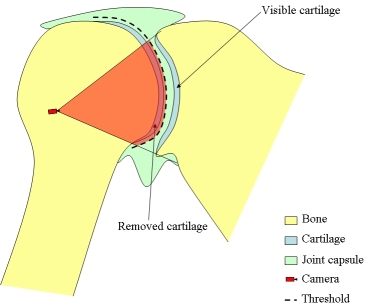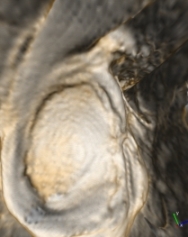Flexible Occlusion Rendering
 Flexible Occlusion Rendering (FOR) is an addition to standard ray cast volume rendering
that modulates accumulated color and opacity along each ray upon detecting features indicating
the separation between objects interest. The goal of this work is to enable more rapid and accurate
diagnosis of pathology from 3D medical images. Separating
the occlusion feature detection from the volume rendering transfer function enables
robust occlusion determination and seamless transition from occluded views to non-occluded
views of surfaces during virtual flythroughs.
Flexible Occlusion Rendering (FOR) is an addition to standard ray cast volume rendering
that modulates accumulated color and opacity along each ray upon detecting features indicating
the separation between objects interest. The goal of this work is to enable more rapid and accurate
diagnosis of pathology from 3D medical images. Separating
the occlusion feature detection from the volume rendering transfer function enables
robust occlusion determination and seamless transition from occluded views to non-occluded
views of surfaces during virtual flythroughs.

FOR has been applied to virtual arthroscopy of joints from Magnetic Resonance Imaging (MRI) data,
such asrendering survey views of entire shoulder socket surfaces to enable rapid evaluation
by automatically removing the occluding material of the humeral head. Such views are not
possible with standard volume rendering. FOR has also been successfully applied to virtual
ureteroscopy of the renal collecting system from Computed Tomography (CT) data, and knee fracture visualization
from CT data.
People
FOR was developed at The University of North Carolina at Chapel Hill (UNC) by
John P. Clarke of Radiology, Russell M. Taylor II of Computer Science, and David Borland, formerly
of Computer Science, currently employed by the Renaissance Computing Institutue.
FOR was the subject of David Borland's Ph.D. thesis, completed in May 2007.
Intellectual Property
International Patent Application No. PCT/US2006/009331, Methods, systems, and computer
programming products for processing three-dimensional image data to render an image
from a viewpoint within or beyond an occluding region of the image data, has been filed by
the inventors, encapsulating portions of the FOR framework. A second provisional patent
application, Flexible Occlusion Rendering has also been filed, covering the remainder
of the full FOR description.
Contact
Those interested in potential licensing of the FOR technology should contact
Trude Amick from UNC's
Office of Technology Development.
 Flexible Occlusion Rendering (FOR) is an addition to standard ray cast volume rendering
that modulates accumulated color and opacity along each ray upon detecting features indicating
the separation between objects interest. The goal of this work is to enable more rapid and accurate
diagnosis of pathology from 3D medical images. Separating
the occlusion feature detection from the volume rendering transfer function enables
robust occlusion determination and seamless transition from occluded views to non-occluded
views of surfaces during virtual flythroughs.
Flexible Occlusion Rendering (FOR) is an addition to standard ray cast volume rendering
that modulates accumulated color and opacity along each ray upon detecting features indicating
the separation between objects interest. The goal of this work is to enable more rapid and accurate
diagnosis of pathology from 3D medical images. Separating
the occlusion feature detection from the volume rendering transfer function enables
robust occlusion determination and seamless transition from occluded views to non-occluded
views of surfaces during virtual flythroughs.
